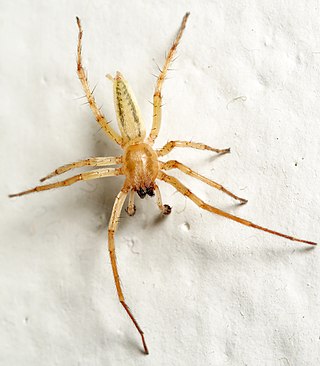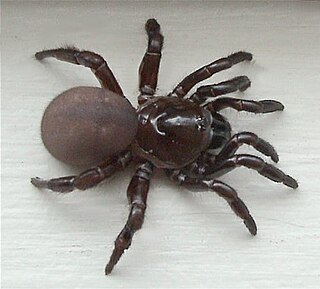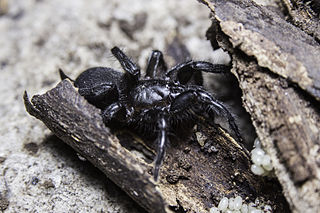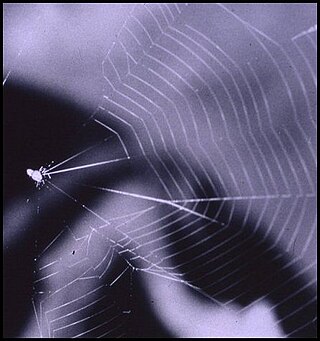
The family Cyrtaucheniidae, known as wafer-lid trapdoor spiders, are a widespread family of Mygalomorphae spiders.

Anyphaenidae is a family of araneomorph spiders, sometimes called anyphaenid sac spiders. They are distinguished from the sac spiders of the family Clubionidae and other spiders by having the abdominal spiracle placed one third to one half of the way anterior to the spinnerets toward the epigastric furrow on the underside of the abdomen. In most spiders the spiracle is just anterior to the spinnerets. Like clubionids, anyphaenids have eight eyes arranged in two rows, conical anterior spinnerets and are wandering predators that build silken retreats, or sacs, usually on plant terminals, between leaves, under bark or under rocks. There are more than 600 species in over 50 genera worldwide.

Oonopidae, also known as goblin spiders, is a family of spiders consisting of over 1,600 described species in about 113 genera worldwide, with total species diversity estimated at 2000 to 2500 species. The type genus of the family is OonopsKeyserling, 1835.

Barychelidae, also known as brushed trapdoor spiders, is a spider family with about 300 species in 42 genera.
Masteria is a genus of curtain web spiders that was first described by L. Koch in 1873. They occur in the tropics of Central to South America, Asia and Micronesia, with one species found in Australia. M. petrunkevitchi males are 4 millimetres (0.16 in) long and females are 5 millimetres (0.20 in) long. M. lewisi, M. barona, and M. downeyi are slightly smaller and have only six eyes.

Pamphobeteus is a genus of tarantulas that was first described by Reginald Innes Pocock in 1901. It includes some of the largest spiders in the world. They are found in South America, including the countries of Peru, Bolivia, Ecuador, Brazil, Colombia and Panama.

Tarantulas comprise a group of large and often hairy spiders of the family Theraphosidae. As of August 2022, 1,040 species have been identified, with 156 genera. The term "tarantula" is usually used to describe members of the family Theraphosidae, although many other members of the same infraorder (Mygalomorphae) are commonly referred to as "tarantulas" or "false tarantulas". Some of the more common species have become popular in the exotic pet trade. Many New World species kept as pets have setae known as urticating hairs that can cause irritation to the skin, and in extreme cases, cause damage to the eyes.

Linothele is a genus of curtain web spiders that was first described by Ferdinand Karsch in 1879. All but one of the described species are from South America. The exception is L. septentrionalis from the far-away Bahamas, although it has certain features that suggest it may belong in another genus. Additionally, an undescribed species of Linothele is known from Panama.
Cyclosternum is a genus of tarantulas that was first described by Anton Ausserer in 1871.

Ummidia is a genus of mygalomorph spiders in the family Halonoproctidae, and was first described by Tamerlan Thorell in 1875.

Sericopelma is a genus of tarantula, found in Central America from Nicaragua to Panama. The limits of the genus and its distribution have long been confused; it is closely related to the genus Aphonopelma. Sericopelma species are among the largest found in Central America. They can be kept as pets, although at least one species has been described as "very aggressive".

Euagrus is a genus of spider in the family Euagridae. It was first described by Anton Ausserer in 1875. It has been referred to as "Evagrus", but this is a transcript error, not an accepted synonym. It is very similar to the genus Allothele, and several species have been transferred there, including Euagrus caffer, Euagrus regnardi, and Euagrus teretis.
Anapis is a genus of araneomorph spiders in the family Anapidae, which consists of small orb weaving spiders all from the Neotropical realm. The genus includes close to thirty species and was first described by Eugène Simon in 1895.
Katissa is a genus of anyphaenid sac spiders first described by Antônio Brescovit in 1997.
Thalerommata is a genus of brushed trapdoor spiders, first described by Anton Ausserer in 1875.

Hapalopus is a genus of tarantulas that was first described by Anton Ausserer in 1875.

Naatlo is a genus of ray spiders that was first described by Jonathan A. Coddington in 1986.












